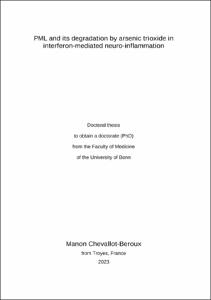Chevallot-Beroux, Manon: PML and its degradation by arsenic trioxide in interferon-mediated neuro-inflammation. - Bonn, 2023. - Dissertation, Rheinische Friedrich-Wilhelms-Universität Bonn.
Online-Ausgabe in bonndoc: https://nbn-resolving.org/urn:nbn:de:hbz:5-69758
Online-Ausgabe in bonndoc: https://nbn-resolving.org/urn:nbn:de:hbz:5-69758
@phdthesis{handle:20.500.11811/10614,
urn: https://nbn-resolving.org/urn:nbn:de:hbz:5-69758,
author = {{Manon Chevallot-Beroux}},
title = {PML and its degradation by arsenic trioxide in interferon-mediated neuro-inflammation},
school = {Rheinische Friedrich-Wilhelms-Universität Bonn},
year = 2023,
month = feb,
note = {Activation of interferon type-I (IFN-I) production and downstream signaling pathways mediate the tissue response to pathogens such as viruses, but its aberrant activation has been suggested to contribute to the aging process and aging-associated neurodegenerative diseases. As a result, the identification of therapeutic avenues for inhibition of the IFN response bears promise for countering tissue aging and IFN-associated diseases. Arsenic trioxide (ATO), an FDA-approved drug against Acute Promyelocytic Leukemia, has been suggested having anti-inflammatory effects in peripheral blood cells. However, the effect of ATO in the context of brain inflammation is unknown. ATO targets the Promyelocytic Leukemia nuclear body (PML-NB), a subnuclear structure involved in the response to stress including viral infections. We found PML upregulated in microglia in interferonopathy models and in amyloid-β plaque-associated microglia in Alzheimer’s disease. We therefore hypothesized that PML-high microglia may be targetable with ATO for suppression of IFN signaling. To test this, we studied the effect of ATO upon viral mimicry and in an interferonopathy model. In vitro and in vivo, we observed that poly I:C-induced inflammation markers in brain microglia were markedly reduced upon ATO, including IFNβ, several chemokines, MHC Class I genes as well as interferon stimulated genes. The inhibitory effect of ATO is only in part PML-dependent and is associated with suppression of STAT1 phosphorylation. We are currently investigating further the mechanism(s) of action of ATO in counteracting brain inflammation, with a particular focus on the link between SUMOylation and STAT1 function. Critically, ATO displayed suppressive effects on microglia activation in interferonopathy models. Taken together, these findings suggest that ATO may represent a promising anti-inflammatory agent in the context of the aging CNS and CNS diseases associated with enhanced IFN signaling.},
url = {https://hdl.handle.net/20.500.11811/10614}
}
urn: https://nbn-resolving.org/urn:nbn:de:hbz:5-69758,
author = {{Manon Chevallot-Beroux}},
title = {PML and its degradation by arsenic trioxide in interferon-mediated neuro-inflammation},
school = {Rheinische Friedrich-Wilhelms-Universität Bonn},
year = 2023,
month = feb,
note = {Activation of interferon type-I (IFN-I) production and downstream signaling pathways mediate the tissue response to pathogens such as viruses, but its aberrant activation has been suggested to contribute to the aging process and aging-associated neurodegenerative diseases. As a result, the identification of therapeutic avenues for inhibition of the IFN response bears promise for countering tissue aging and IFN-associated diseases. Arsenic trioxide (ATO), an FDA-approved drug against Acute Promyelocytic Leukemia, has been suggested having anti-inflammatory effects in peripheral blood cells. However, the effect of ATO in the context of brain inflammation is unknown. ATO targets the Promyelocytic Leukemia nuclear body (PML-NB), a subnuclear structure involved in the response to stress including viral infections. We found PML upregulated in microglia in interferonopathy models and in amyloid-β plaque-associated microglia in Alzheimer’s disease. We therefore hypothesized that PML-high microglia may be targetable with ATO for suppression of IFN signaling. To test this, we studied the effect of ATO upon viral mimicry and in an interferonopathy model. In vitro and in vivo, we observed that poly I:C-induced inflammation markers in brain microglia were markedly reduced upon ATO, including IFNβ, several chemokines, MHC Class I genes as well as interferon stimulated genes. The inhibitory effect of ATO is only in part PML-dependent and is associated with suppression of STAT1 phosphorylation. We are currently investigating further the mechanism(s) of action of ATO in counteracting brain inflammation, with a particular focus on the link between SUMOylation and STAT1 function. Critically, ATO displayed suppressive effects on microglia activation in interferonopathy models. Taken together, these findings suggest that ATO may represent a promising anti-inflammatory agent in the context of the aging CNS and CNS diseases associated with enhanced IFN signaling.},
url = {https://hdl.handle.net/20.500.11811/10614}
}






